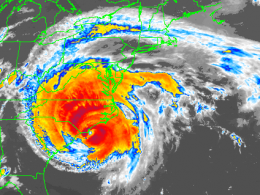September is peak month for hurricanes in North Carolina

More hurricanes and tropical storms hit North Carolina in September than in any other month. Two UNC experts explain how state residents can stay safe and healthy before and after a dangerous storm.
As Tropical Storm Maria churns in the Atlantic toward the East Coast, North Carolina residents are still drying out from the remnants of Tropical Storm Lee. Meanwhile, people in eastern part of the state are rebuilding from damage caused by Hurricane Irene, which hit the coast in late August.
Nearly 70 tropical storms or hurricanes have made landfall in North Carolina since 1851, according to the State Climate Office of North Carolina. More of those storms hit the state in September than in any other month.
Among the storms that have slammed North Carolina in September are Hurricane Fran, which swept from the coast through the Triangle in 1996, and Hurricane Floyd, which killed 35 state residents and caused $3 billion in damage in 1999.
Because hurricanes are common in the state, every resident should know how to stay safe during and after the storms. Read on for tips from Dalton Sawyer, director of emergency preparedness and business continuity planning for UNC Health Care, and James Larson, MD, medical director of the Emergency Department at UNC Hospitals.
How to prepare for a hurricane
Before storm season begins, you can prepare by creating an emergency medical plan with your physicians, Sawyer said. Talk to your doctors about how to get in touch with them after a hurricane, and about where you can find medical care if they are not available. Making this plan will save you time and stress if, for example, your child develops a fever during a storm or you can’t reach the specialist who usually cares for you.
Create a portable health record for yourself and your family members, Sawyer said. It can be as simple as a USB or thumb drive that contains electronic copies of your medical history, your medical cards and lists of physicians and hospitals. If you stay at a Red Cross shelter or hotel during an emergency, you’ll be able to print out the information to give to the people helping you.
If officials ask you to evacuate, do it, Larson said. Keep in mind that highways can be crowded during an evacuation, so make sure you leave with plenty of time to get out.
If you decide not to evacuate, make sure you have water, a minimum of one gallon per person for three days, plus water for pets. Be prepared to take care of yourself for two or three days. “You never know how long it’s going to take to get back to normal,” Larson said.
If you have a medical condition, you should also stock up on medicine: enough for between five and seven days. You should also obtain copies of your prescriptions.
If you have special medical needs or are medically fragile, make sure you have enough of what you need to sustain life, such as a generator to run your ventilator. You should also talk with local authorities about being placed on a list of people with special needs who should be prioritized for rescue, Sawyer said. Meanwhile, talk with your doctors and neighbors about your plans.
Designate one person to be in charge of communicating with the outside world. You will want to avoid receiving frequent phone calls, because that will run down your phone battery and you may not be able to recharge it. You may also be able to alert others of your situation through social media or through the Red Cross “Safe and Well” initiative, which allows participants to list themselves as safe (safeandwell.communityos.org/cms/index.php).
Staying safe in the aftermath
After the storm has passed, avoid crossing flooded roadways. Fifty-five percent of the deaths caused by Hurricane Floyd were vehicle-related, and many people died by drowning in inland waters.
“If it’s anything more than a puddle, I would avoid it, and avoid driving around in general after something like that,” Larson said.
Use common sense as you clean up your property. If you don’t have experience with power tools, don’t use them. Larson said that many people injure themselves with chain saws in the days following a major storm.
Wear gloves and protective clothing as you clean up to avoid cuts.
Treat any downed power lines as potentially dangerous.
Above all, take care of yourself: Get plenty of rest, and ask for help if you need it.
In some cases, the stress of a storm can affect a person’s mental health. The Centers for Disease Control and Prevention documented a statistically significant increase in suicide attempts following Hurricane Floyd in 1999, compared to a similar period in 1998.
You should also closely monitor other chronic conditions, such as heart ailments.
“We definitely see exacerbations of heart problems,” Larson said. “Longstanding, chronic disease can get worse when subjected to stress and lack of electricity.”















